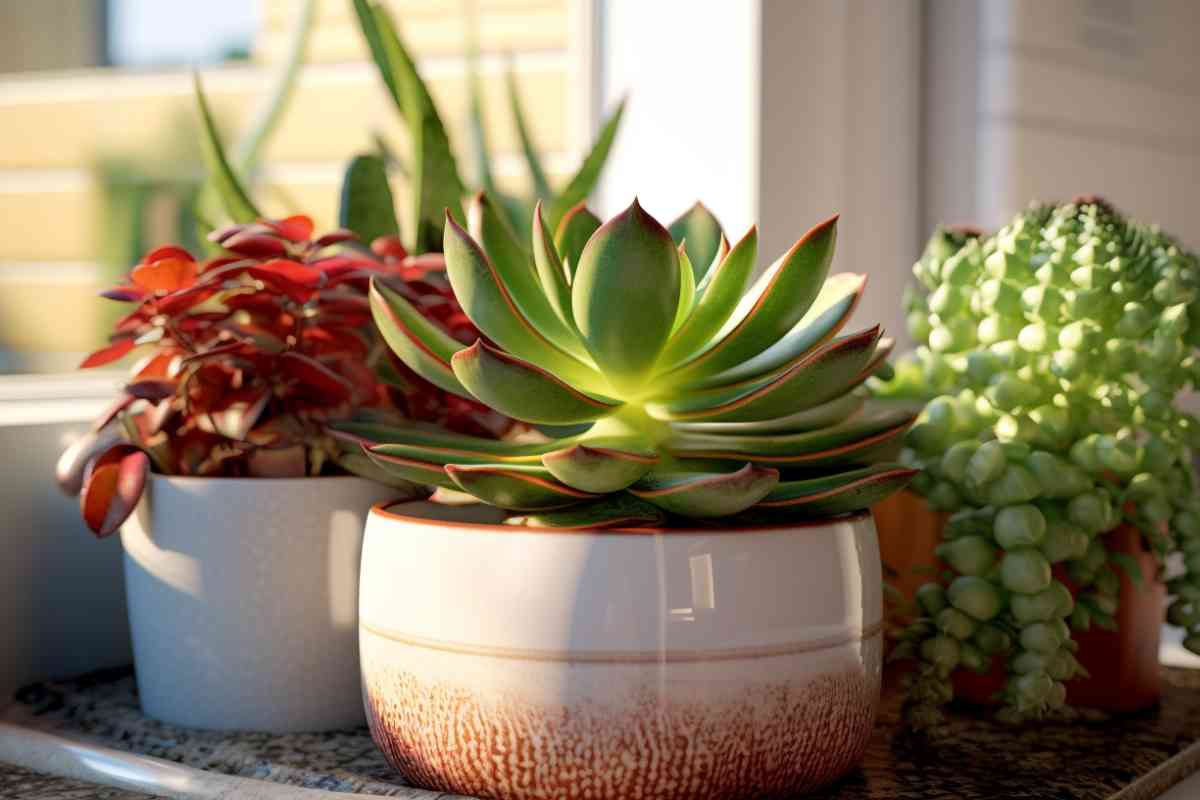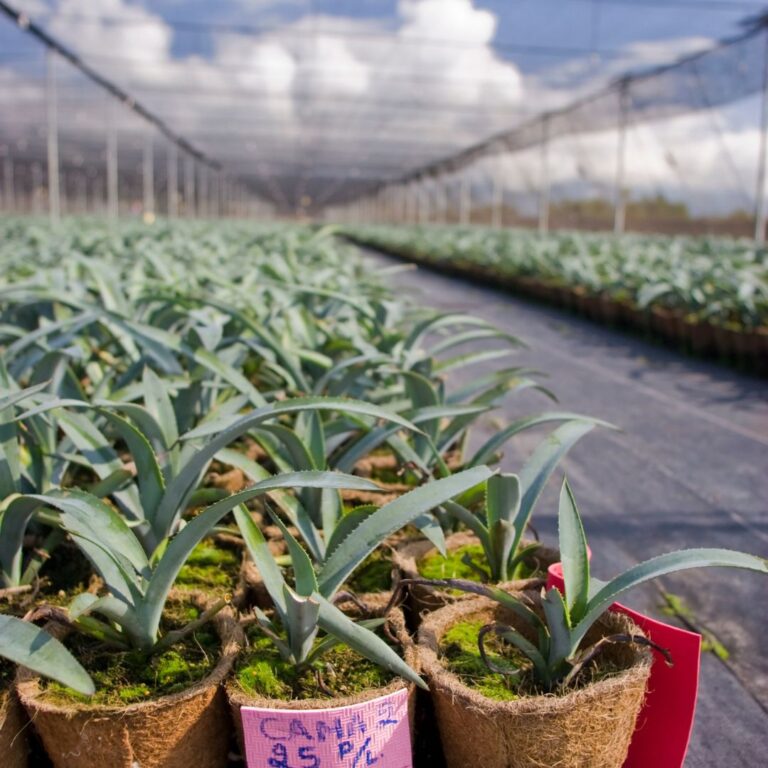How to Make Succulent Soil Without Perlite: A Comprehensive Guide

While many succulent soil recipes call for perlite, a volcanic glass that helps with drainage, it is not necessary. It’s totally possible to make succulent soil without perlite. In fact, I find that perlite holds a bit too much moisture for my taste, since I live in a humid climate with lots of rain.
If you too want perlite-free succulent soil, I’ve got you covered. Here are all of the alternatives to perlite to keep your succulents in peek condition.

How to Make Succulent Soil Without Perlite?
Pumice, coarse sand, poultry grit, small lava rocks, and rice hulls are excellent alternatives to perlite for succulent soil. They provide similar benefits, such as drainage, aeration, and moisture regulation, without perlite’s potential concerns. Adjust ratios to suit specific succulent needs and environmental conditions.
Here’s everything you need to know to make the perfect soil for your succulents, no need for perlite.
Looking for organic, sustainable gardening ideas? Here’s how you can fertilize your succulents naturally.
Wondering whether all of this succulent soil you’ve created is good for anything else? Here are other plants that do well with succulent soil.
The Importance of Soil for Succulents
Soil is an essential element for the growth and survival of all plants, including succulents. The right soil mixture provides the necessary nutrients, drainage, and aeration for succulents to thrive. It is crucial to choose the right type of soil for succulents, as they have unique needs.
One of the essential factors to consider when selecting soil for succulents is porosity. Succulents need a well-draining soil mix that allows excess water to drain away quickly. Without proper drainage, succulents suffer from root rot, which can be fatal.
Succulents prefer a porous sandy potting soil that allows air to circulate around the roots. Sandy soil is ideal for succulents as it provides excellent drainage and prevents water from accumulating around the roots.
Garden soil or regular potting soil is not suitable for succulents as they retain too much moisture and do not provide enough aeration. Instead, it is best to use a specialized succulent soil mix.

Why Perlite-Free Soil
Perlite is a common ingredient in many succulent soil mixes. It is a lightweight volcanic glass that helps with moisture drainage and aeration. However, some growers prefer to avoid using perlite in their soil mixes for various reasons. In this section, we will explore the benefits of using perlite-free soil for your succulents.
Avoid Too Much Moisture Retention
While it does help enhance soil structure, fine perlite, when used excessively or without proper consideration, can indeed retain too much moisture for succulents.
Fine perlite has smaller particle sizes compared to coarse perlite, which makes it more prone to compacting in the soil mix. When perlite particles compact, they create smaller air pockets, reducing the overall soil porosity and hindering proper drainage. This can lead to waterlogged soil and create a moisture-retentive environment around the succulent’s roots.
Succulents are adapted to arid conditions and prefer well-draining soils that allow excess water to escape quickly. If the soil holds onto too much moisture, the succulent’s roots can become waterlogged, promoting root rot and other fungal issues. Over time, this can weaken the plant and even lead to its demise.
It’s important to opt for coarser-grade perlite instead of fine particles. Coarse perlite maintains larger air pockets in the soil, ensuring better aeration and drainage. However, these particles may be too large for small succulents.

Sustainability
Perlite is a naturally occurring volcanic rock. To make it suitable for gardening, the raw perlite is mined from the earth and undergoes an energy-intensive process called expansion. During this process, the perlite is heated rapidly, causing it to expand and form lightweight, porous particles. Additionally, perlite is sterilized to remove any potential pathogens or contaminants that could harm plants.
The environmental impact of perlite production and processing is a concern for some environmentally conscious gardeners. The mining and energy-intensive expansion process contribute to greenhouse gas emissions and energy consumption. Furthermore, mining can have disruptive effects on ecosystems and biodiversity.
Aesthetic Appeal
Unlike perlite, which can create noticeable white specks in the soil mix, perlite-free soil maintains a more consistent color and texture throughout. This cohesive look can enhance the overall beauty of potted plants, creating a clean and refined aesthetic.
Furthermore, perlite-free soil often has a more earthy and natural feel. Gardeners who appreciate the beauty of raw and unadorned materials may find perlite-free soil visually appealing due to its simplicity.
In decorative planters or arrangements, where the soil might be visible through the container’s openings or gaps, using perlite-free soil can create a seamless and elegant presentation. The absence of contrasting white perlite particles allows the focus to remain on the plants themselves, showcasing their unique colors, shapes, and textures.

Avoiding Airborne Particles
Perlite, being a lightweight and porous material, can generate fine dust particles when handled or disturbed.
For individuals with respiratory issues like asthma, bronchitis, or allergies, exposure to airborne particles can trigger respiratory discomfort or exacerbate existing conditions. Inhaling perlite dust may irritate the airways and cause coughing, wheezing, or shortness of breath.
By choosing perlite-free soil, gardeners can eliminate the potential concern of airborne particles and create a more allergy-friendly gardening environment.
Perlite-free soil is generally safer for children and pets, especially birds, as they may be more susceptible to respiratory issues due to their smaller lung capacity and vulnerability to environmental irritants.
Key Ingredients for Succulent Soil
When it comes to making succulent soil, there are a few key ingredients that you will need to ensure that your plants thrive. While perlite is a commonly used ingredient in succulent soil, it is not the only option available. Here are some of the best ingredients to use when making succulent soil without perlite:
Inorganic Ingredients for Succulent Soil
Perlite is inorganic, so when choosing a mix for your succulent soil, replace perlite with one or more of the following:
Coarse Sand
Sand is a great ingredient to use in succulent soil as it helps to improve drainage and prevent water from pooling around the roots. However, it is important to use coarse sand rather than fine sand, as fine sand can actually create a compacted soil that holds onto water.

[amazon box=”B0836KYKK2″]
Pumice
Pumice is a lightweight volcanic rock that is perfect for succulent soil as it is highly porous and helps to improve drainage. It also provides aeration to the roots of your plants, which is essential for healthy growth.
Fine Gravel
Gravel is a great ingredient to use in succulent soil as it helps to improve drainage and prevent water from pooling around the roots. Use only fine washed gravel that is free from dust and debris. The gravel you use shouldn’t be much bigger than the grains of coarse sand.

[amazon box=”B07VQ3CKQW”]
Turface
Turface is a calcined clay that is highly porous and helps to improve drainage in succulent soil. It is also a great option for improving aeration around the roots of your plants.
Rice Hulls
Rice hulls, also known as rice husks, are the protective outer coverings of rice grains. They are a byproduct of rice milling and are often used in gardening and horticulture as a sustainable and beneficial potting medium for various plants, including succulents.
Rice hulls have a porous and lightweight structure, promoting excellent aeration and drainage in the potting mix. While rice hulls provide good drainage, they also retain some moisture, creating a balanced environment for succulents.
Rice hulls are a sustainable and eco-friendly choice for gardening since they are a byproduct of rice processing that would otherwise go to waste.
Poultry Grit
Poultry grit is a type of crushed stone or gravel that is typically used as a dietary supplement for poultry, helping them to digest their food. However, it can also be used as a planting medium for succulents.
Poultry grit is made of coarse, crushed stones, providing excellent drainage properties. It allows excess water to flow through the soil quickly, preventing waterlogged conditions that can lead to root rot in succulents.
The coarse texture of poultry grit creates air pockets in the soil, improving aeration for the plant roots.

[amazon box=”B083ZL7RWW”]
Lava Rock
Lava rocks have a porous and lightweight structure, allowing water to quickly pass through the soil. This excellent drainage prevents water from accumulating around the roots, reducing the risk of root rot and other water-related issues in succulents.
Furthermore, lava rocks provide excellent support for succulent roots, helping to anchor the plants securely in their containers or garden beds.
Organic Ingredients for Succulent Soil
Coconut Coir
Coconut coir is a natural fiber that is made from the husks of coconuts. It is an excellent alternative to peat moss, which is not sustainable and is difficult to rehydrate once it’s dried. Coconut coir helps to improve drainage and aeration in succulent soil, while also retaining moisture.
Compost
Compost is a great ingredient to add to succulent soil as it provides essential nutrients to your plants. Use a high-quality compost that is free from weed seeds and pathogens, and ensure it doesn’t contain much fine sand which can impede drainage.
Pine Bark
Pine bark, for example, is a great option as it is highly porous and helps to improve drainage. However, it is important to use only well-aged pine bark, as fresh pine bark can be acidic and harmful to your plants.
Creating Your Own Succulent Soil
If you want to create your own succulent soil without perlite, you have several options. Here are a few DIY succulent soil recipes that you can use to make your own potting mix:
Recipe 1: Sand and Soil Mix
This is a simple recipe that requires only two ingredients: sand and soil. The sand provides good drainage, while the soil provides nutrients for the plants.
To make this mix, you will need:
- Coarse sand
- Potting soil
Mix the sand and soil in a 1:1 ratio. You can adjust the ratio depending on the needs of your succulents. This mix works well for many succulents and cacti.
Recipe 2: Sand, Soil, and Compost Mix
This recipe is similar to the first one, but it includes compost for added nutrients. Compost also helps to improve soil structure and water retention, so if your succulents are drying out too quickly with the first recipe, this might be the one for you.
To make this mix, you will need:
- Coarse sand
- Potting soil
- Compost
Mix the soil and compost in a 1:1 ratio and then mix with the sand and in 1:1 ratio. Again, you can adjust the ratio depending on your plants’ needs.

Recipe 3: Sand, Coconut Coir, and Soil Mix
This recipe is ideal for succulents that require more moisture. Coconut coir is a good alternative to peat moss, which is not sustainable. Coconut coir is also a good option for those who want to avoid using perlite.
To make this mix, you will need:
- Coarse sand
- Coconut coir
- Potting soil
Mix the sand, coconut coir, and soil in a 1:1:1 ratio. This mix is good for succulents that require more moisture, such as haworthias and some echeverias.
Recipe 4: Sand, Pine Bark, and Soil Mix
This recipe is similar to the first one, but it includes pine bark for added drainage. Pine bark also helps to improve soil structure and aeration.
To make this mix, you will need:
- Coarse sand
- Pine bark
- Potting soil
Mix the sand, pine bark, and soil in a 1:1:1 ratio. This mix is good for succulents that require more drainage, such as lithops and some sedums.
Best Soil Mix for the Top 10 Popular Succulents Species
- Echeveria: A well-draining mix is crucial to prevent root rot. Combine 2 parts coarse sand or poultry grit with 1 part coconut coir for moisture retention and 1 part pumice or small lava rocks for aeration.
- Sedum: Thrives in well-aerated and fast-draining soil. Use 2 parts coarse sand or poultry grit, 1 part coconut coir for moisture, and 1 part pumice or small lava rocks for added drainage.
- Crassula: Requires a well-draining mix to prevent overwatering. Blend 2 parts coarse sand or poultry grit with 1 part coconut coir and 1 part pumice or small lava rocks.
- Haworthia: Needs a mix that retains some moisture without becoming waterlogged. Combine 2 parts coarse sand or poultry grit with 1 part coconut coir and 1 part compost or well-rotted organic matter.
- Aloe: Benefits from a soil mix that provides good drainage and aeration. Mix 2 parts coarse sand or poultry grit, 1 part coconut coir, and 1 part pumice or small lava rocks.
- Sempervivum (Hens and Chicks): Thrives in well-draining, gritty soil. Use 2 parts coarse sand or poultry grit and 2 parts pumice or small lava rocks.
- Kalanchoe: Prefers a mix with excellent drainage to avoid root issues. Combine 2 parts coarse sand or poultry grit with 1 part coconut coir and 1 part pumice or small lava rocks.
- Agave: Needs a well-draining mix to prevent root rot. Use 2 parts coarse sand or poultry grit and 1 part pumice or small lava rocks.
- Aeonium: Requires a mix with good drainage and aeration. Blend 2 parts coarse sand or poultry grit with 1 part coconut coir and 1 part pumice or small lava rocks.
- Senecio (String of Pearls): Thrives in well-draining soil. Mix 2 parts coarse sand or poultry grit with 1 part coconut coir and 1 part pumice or small lava rocks.
Remember, these are just example recipes, and the proportions can be adjusted based on your succulents’ needs and the environmental conditions they are grown in. The goal is to create a well-draining soil mix that promotes healthy root growth, prevents waterlogged conditions, and provides essential nutrients for your succulents to thrive.
The Mixing Process
Start by measuring out the ingredients using a measuring cup or measuring container.
- Once you have measured out the ingredients, add them to a mixing container. A large bucket or plastic container works well for this purpose.
- Use a trowel to mix the ingredients together thoroughly. Make sure to break up any clumps of soil or coco coir to ensure an even mix. I find shaking the bucket some helps a lot.
- As you mix, check the consistency of the soil. It should be light, not compressed, and all the ingredients should merge evenly together.
- Once the soil is mixed to your desired consistency, it’s ready to use! Fill your pots or planters with the soil and plant your succulents as you normally would.
Storing Succulent Soil
To store your homemade succulent soil, consider using a storage bin with a tight-fitting lid to keep out moisture and pests. This will prolong the shelf life of your soil and prevent it from becoming contaminated. Be sure to label the bin with the date and type of soil mixture for future reference.
Sterilization Process
Sterilizing soil can be a useful step in making succulent soil without perlite. It helps to eliminate any harmful bacteria, fungi, or pests that may be present in the soil. There are different ways to sterilize soil, but oven sterilization is one of the most effective and convenient methods.
To sterilize soil in the oven, follow these simple steps:
- Preheat your oven to 180-200°F (82-93°C).
- Collect the soil you want to sterilize and spread it out in a thin layer on a baking sheet.
- Place the baking sheet in the oven and bake the soil for 30 minutes.
- After 30 minutes, turn off the oven and let the soil cool down completely before using it.
It is important to note that oven sterilization can alter the soil’s properties, such as its pH level and nutrient content. Therefore, it is recommended to add some amendments, such as compost, to the soil after sterilization to restore its fertility.

Do succulents even need soil? They seem able to survive for a long time with no soil at all.
Wondering how often to fertilize your succulents based on what kind of soil you’re using? Here’s a rundown on how often to fertilize succulents.
Frequently Asked Questions
What are some alternatives to perlite for making succulent soil?
Some alternatives to perlite for making succulent soil include pumice, coarse sand, grit, and crushed granite. These materials provide good drainage and aeration for the soil.
What is the best DIY succulent soil mix without perlite?
The best DIY succulent soil mix without perlite is a combination of potting soil, coarse sand, and a gritty material such as pumice or crushed granite. The ratio of these ingredients can vary depending on the specific needs of your succulent.
What is the cheapest way to make succulent soil without perlite?
The cheapest way to make succulent soil without perlite is to use a combination of potting soil and coarse sand. This mixture will provide adequate drainage and aeration for your succulent while being budget-friendly.
Can you use cactus soil instead of perlite for succulent soil?
Cactus soil can be used instead of perlite for succulent soil, but it may not provide enough drainage for some succulent species. It is best to mix cactus soil with a gritty material such as coarse sand or crushed granite to ensure adequate drainage.
How do you make a succulent soil mix without sand and perlite?
To make a succulent soil mix without sand and perlite, you can use a combination of potting soil, peat moss, and a gritty material such as pumice or crushed granite. The ratio of these ingredients can vary depending on the specific needs of your succulent.
What is the ideal ratio for a succulent soil mix without perlite?
The ideal ratio for a succulent soil mix without perlite is 2 parts potting soil, 1 part coarse sand, and 1 part gritty material such as pumice or crushed granite. This mixture will provide adequate drainage and aeration for most succulent species.
Some alternatives to perlite for making succulent soil include pumice, coarse sand, grit, and crushed granite. These materials provide good drainage and aeration for the soil.
“}},{“@type”:”Question”,”name”:”What is the best DIY succulent soil mix without perlite?”,”acceptedAnswer”:{“@type”:”Answer”,”text”:”
The best DIY succulent soil mix without perlite is a combination of potting soil, coarse sand, and a gritty material such as pumice or crushed granite. The ratio of these ingredients can vary depending on the specific needs of your succulent.
“}},{“@type”:”Question”,”name”:”What is the cheapest way to make succulent soil without perlite?”,”acceptedAnswer”:{“@type”:”Answer”,”text”:”
The cheapest way to make succulent soil without perlite is to use a combination of potting soil and coarse sand. This mixture will provide adequate drainage and aeration for your succulent while being budget-friendly.
“}},{“@type”:”Question”,”name”:”Can you use cactus soil instead of perlite for succulent soil?”,”acceptedAnswer”:{“@type”:”Answer”,”text”:”
Cactus soil can be used instead of perlite for succulent soil, but it may not provide enough drainage for some succulent species. It is best to mix cactus soil with a gritty material such as coarse sand or crushed granite to ensure adequate drainage.
“}},{“@type”:”Question”,”name”:”How do you make a succulent soil mix without sand and perlite?”,”acceptedAnswer”:{“@type”:”Answer”,”text”:”
To make a succulent soil mix without sand and perlite, you can use a combination of potting soil, peat moss, and a gritty material such as pumice or crushed granite. The ratio of these ingredients can vary depending on the specific needs of your succulent.
“}},{“@type”:”Question”,”name”:”What is the ideal ratio for a succulent soil mix without perlite?”,”acceptedAnswer”:{“@type”:”Answer”,”text”:”
The ideal ratio for a succulent soil mix without perlite is 2 parts potting soil, 1 part coarse sand, and 1 part gritty material such as pumice or crushed granite. This mixture will provide adequate drainage and aeration for most succulent species.
“}}]}



